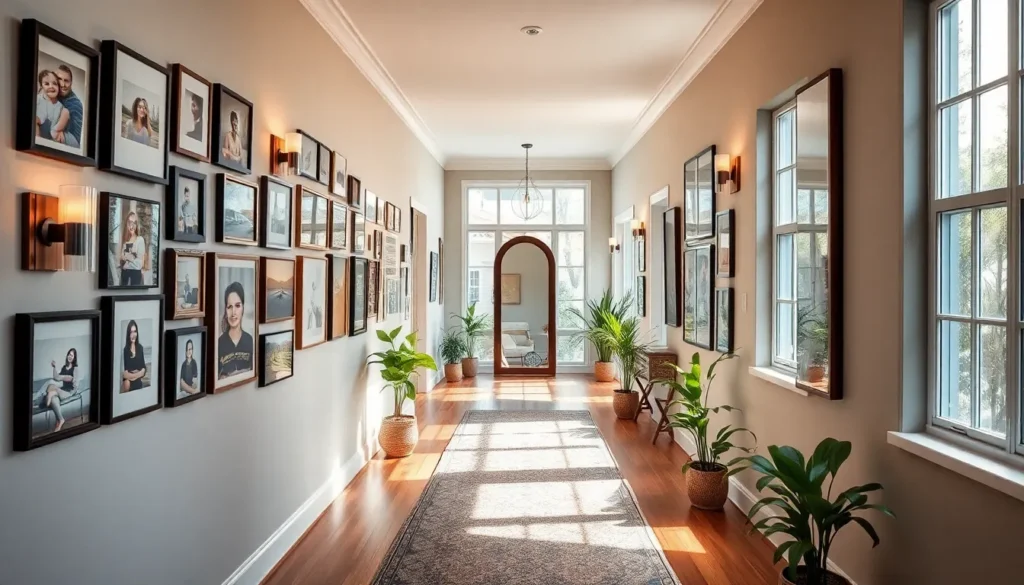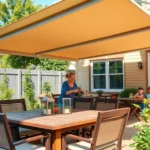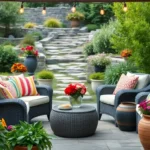Long hallways often get overlooked in home design yet they’re some of the most transitional spaces in our homes. We walk through these corridors multiple times daily but rarely give them the attention they deserve. The truth is these elongated spaces present unique decorating challenges that can leave us feeling stumped about how to make them both functional and visually appealing.
The good news? We’ve discovered that narrow hallways are actually hidden gems waiting to be transformed into stunning design features. With the right decorating strategies you can turn your boring corridor into a captivating gallery space that connects your rooms with style and purpose.
Whether you’re dealing with a dark narrow passage or a long wide hallway we’ll share proven techniques that maximize visual impact while maintaining functionality. From strategic lighting answers to clever storage ideas these approaches will help you create a hallway that’s anything but an afterthought.
Create Visual Interest With Gallery Walls
Gallery walls transform long hallways from boring passageways into stunning visual experiences. We can turn these narrow spaces into personal art galleries that capture attention and reflect our unique style.
Choose a Cohesive Theme or Color Palette
Selecting a unified theme creates harmony throughout your hallway gallery wall. We recommend choosing colors that complement your existing decor, such as black and white photography for modern homes or warm earth tones for rustic spaces. Botanical prints work beautifully in nature-inspired interiors, while abstract art suits contemporary settings perfectly.
Color coordination doesn’t mean everything must match exactly. We suggest picking 2-3 dominant colors and letting them flow through your entire collection. Neutral frames in white, black, or natural wood help tie different pieces together seamlessly. This approach ensures your gallery wall feels intentional rather than randomly assembled.
Mix Different Frame Sizes and Shapes
Varying frame dimensions adds ever-changing visual rhythm to your hallway display. We start with one large statement piece as an anchor, then surround it with medium and small frames in different proportions. Square frames paired with rectangular ones create pleasing geometric contrast that draws the eye forward down the hallway.
Creating templates on paper helps us plan the perfect arrangement before hanging anything. We cut paper shapes matching each frame size and tape them to the wall, allowing us to experiment with different layouts. This method prevents unnecessary holes and ensures optimal spacing between pieces. Standard spacing of 2-3 inches between frames maintains visual cohesion while allowing each piece to breathe.
Include Personal Photos and Artwork
Personal touches make gallery walls truly meaningful and conversation-worthy. We blend family photographs with collected artwork, vintage finds, and even children’s drawings to create displays that tell our unique stories. Travel photos from memorable trips add worldly sophistication when mixed with local art pieces or vintage postcards.
Balance is key when combining personal items with purchased art. We recommend following the 60-30-10 rule: 60% purchased or formal artwork, 30% personal photographs, and 10% unique collectibles or three-dimensional objects like small shelves or sculptural elements. This ratio ensures professional polish while maintaining personal warmth that makes guests feel welcome in our homes.
Add Functional Storage Solutions
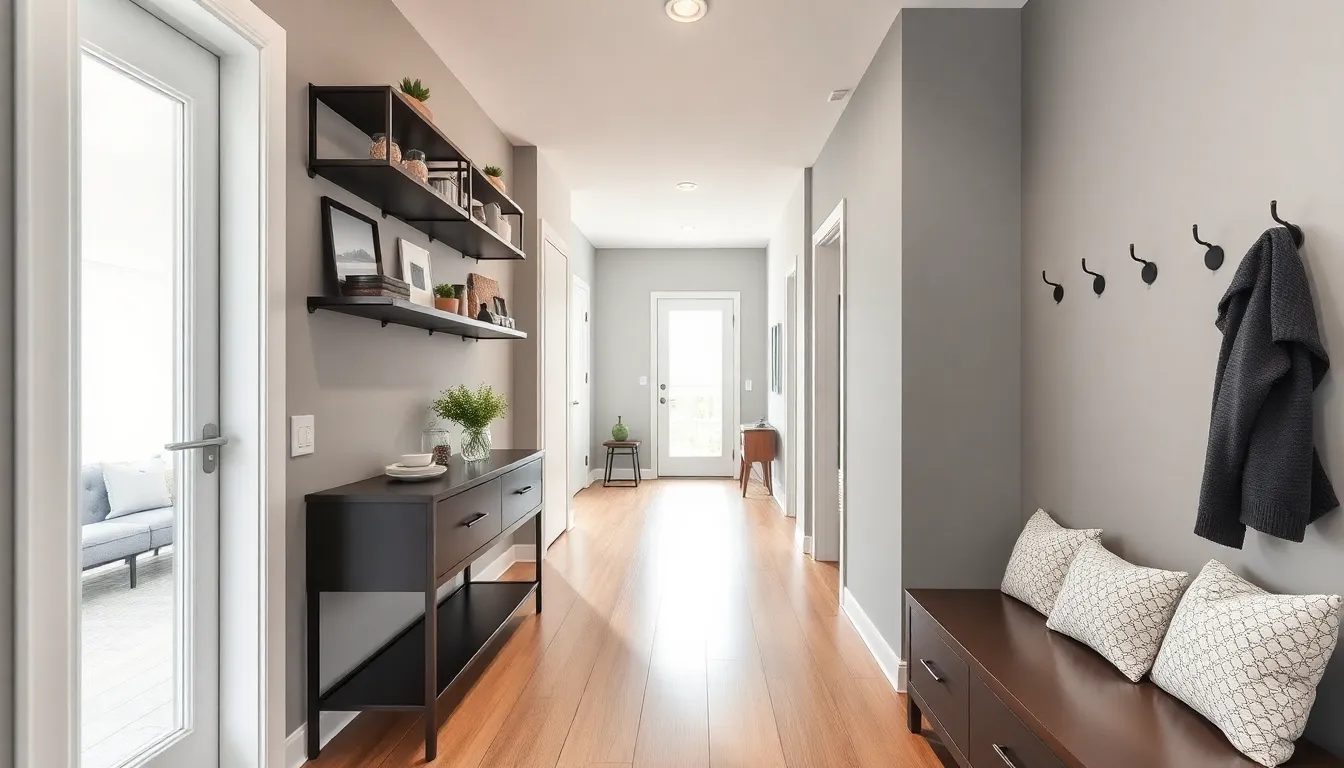
Long hallways naturally collect everyday items like shoes, coats, keys, and mail, making functional storage essential for maintaining both organization and visual appeal. We’ll explore three effective storage strategies that maximize your hallway’s potential while keeping the space looking polished.
Install Floating Shelves for Display and Storage
Floating shelves offer vertical storage without consuming precious floor space, making them perfect for narrow hallways where every inch counts. We can display decorative items, books, or store daily essentials like keys and mail on these sleek additions. Open shelving transforms a hallway into a mini library while visually elongating the space through horizontal lines.
Installing multiple shelves at varying heights creates visual interest and provides different storage zones for various items. Books and decorative objects work well on higher shelves, while lower shelves can hold frequently accessed items like mail or small baskets for keys. Keep in mind that open shelving requires more frequent dusting and creates less seamlessness compared to built-in options.
Use Console Tables With Drawers
Console tables with drawers provide the perfect combination of display surfaces and hidden storage for smaller items such as letters, gloves, or accessories. We recommend choosing slim designs that won’t crowd your hallway while still offering maximum functionality. Tables with multiple drawers allow for better organization of different item categories.
Matching console tables with decorative baskets underneath maximizes storage capacity without overwhelming the corridor’s visual flow. Drawer storage keeps clutter completely out of sight while the tabletop surface can showcase decorative elements like plants, artwork, or a stylish lamp. Opt for pieces that complement your hallway’s existing color scheme to maintain cohesion.
Incorporate Built-in Storage Benches
Built-in benches with storage underneath offer dual functionality by providing both seating and hidden compartments for shoes, bags, or seasonal items. We suggest integrating hooks above the bench for coats and umbrellas to create a comprehensive multi-functional entryway system. These custom answers look incredibly sleek and streamlined when properly designed.
Planning built-in storage during renovations or new construction provides the most customized and polished results, though installation can be costly and complex. Storage benches work particularly well near entryways or at hallway endpoints where people naturally pause. Custom cushions in coordinating fabrics can enhance comfort while maintaining your design aesthetic.
Illuminate Your Space With Strategic Lighting
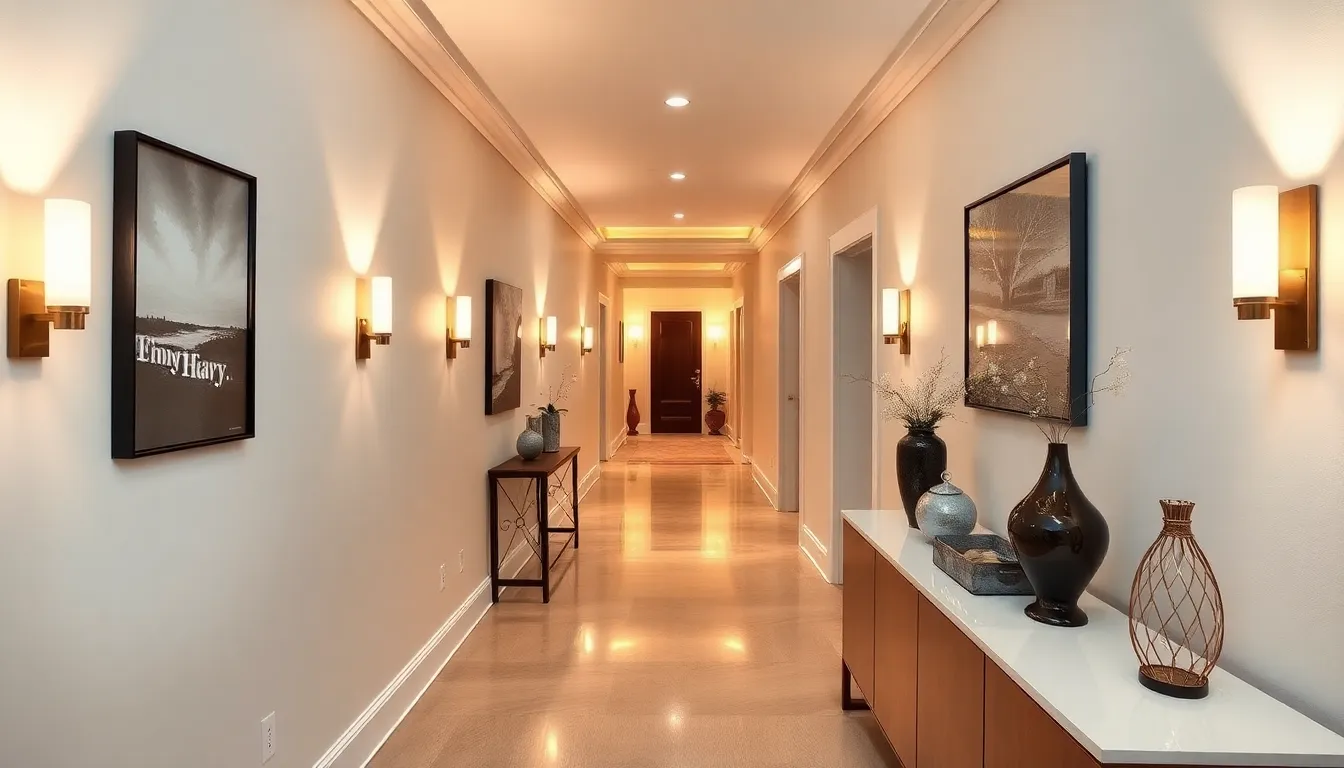
Proper lighting transforms a dark corridor into an inviting pathway that enhances your home’s overall design. We’ll explore three essential lighting strategies that create depth and visual interest in your long hallway.
Layer Different Types of Lighting Fixtures
Combining ambient, task, and accent lighting creates a sophisticated lighting scheme that eliminates harsh shadows and adds visual depth. Ambient lighting serves as your base layer, providing general illumination throughout the space. Task lighting focuses on exact areas where you need brighter light for activities like reading mail or finding keys. Accent lighting highlights architectural features, artwork, or decorative elements to create focal points.
We recommend installing overhead fixtures like flush mount ceiling lights or track lighting for ambient illumination. Directional spotlights work perfectly as accent lighting to highlight your gallery wall or architectural details. This layered approach prevents the tunnel effect that single overhead lights often create in narrow spaces.
Install Wall Sconces for Ambient Lighting
Wall sconces provide excellent ambient lighting while adding decorative appeal to your hallway walls. These fixtures distribute light evenly without taking up floor space, making them ideal for narrow corridors. We suggest mounting sconces at eye level, approximately 60 to 66 inches from the floor, to create the most flattering illumination.
Choose sconces with upward and downward light distribution to maximize the ambient effect. This type of lighting bounces off both the ceiling and floor, creating a soft glow that makes the space feel wider. Position sconces every 8 to 10 feet along longer hallways to maintain consistent lighting levels throughout the entire corridor.
Add Table Lamps on Console Surfaces
Table lamps on console tables create cozy task lighting while contributing to your hallway’s decorative scheme. These fixtures offer warm, intimate illumination that complements your ambient lighting layers. We recommend using lamps with fabric shades that diffuse light softly rather than creating harsh bright spots.
Place lamps at varying heights to add visual rhythm to your console arrangement. A 24 to 27 inch tall lamp works well on most standard console tables, providing adequate light without overwhelming the space. Consider using battery operated LED table lamps if electrical outlets are limited, ensuring you can position lighting exactly where it’s most effective for both function and aesthetics.
Transform Walls With Paint and Wallpaper
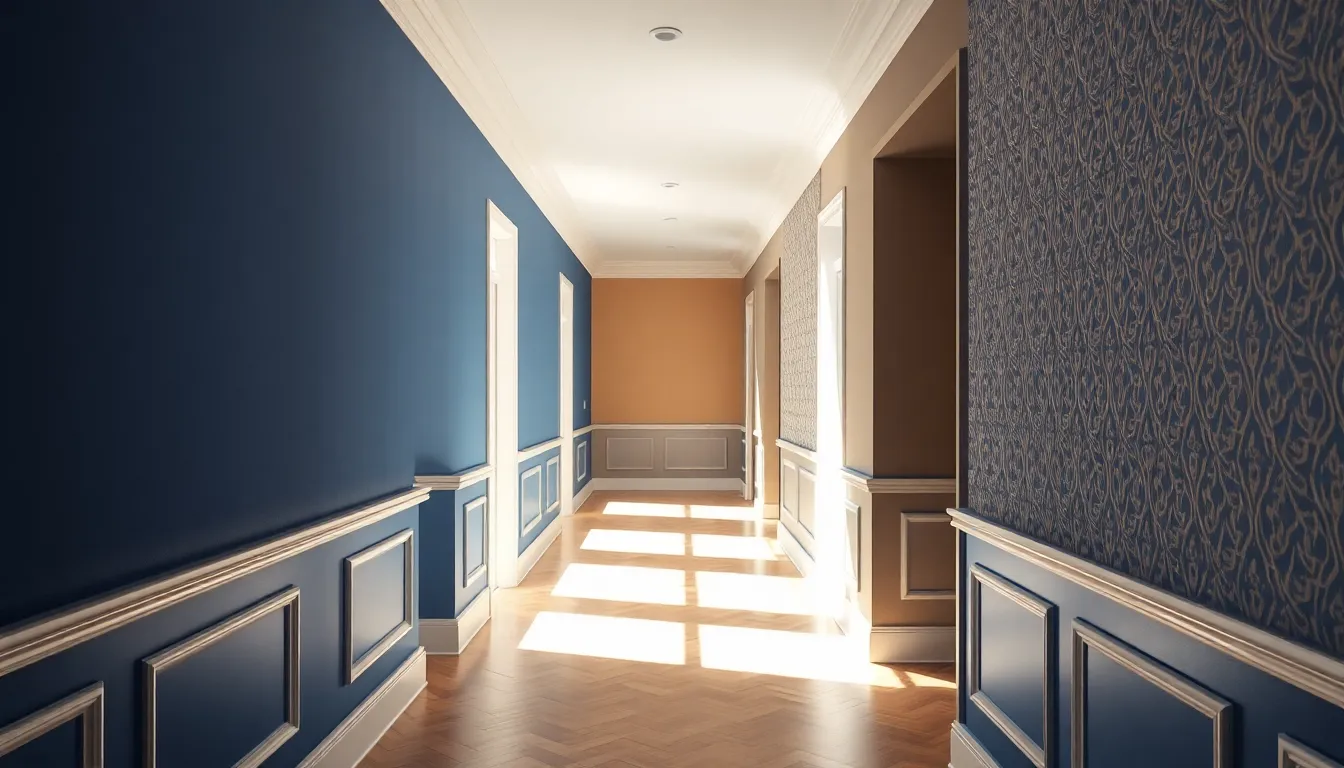
Now that we’ve covered lighting and storage answers, let’s explore how strategic wall treatments can completely transform your long hallway’s visual impact. Paint and wallpaper offer powerful tools for turning bare corridor walls into stunning design statements.
Use Bold Accent Colors to Create Drama
Bold accent colors inject instant personality into long hallways that might otherwise feel monotonous. We recommend selecting deep blues or forest greens for a focal wall to create visual depth and sophistication. These rich hues work particularly well when applied to architectural features like recessed areas or the wall at the hallway’s end.
Creating drama doesn’t mean overwhelming the space with color everywhere. Choose one strategic wall as your accent point while keeping adjacent walls in complementary neutral tones. This approach draws the eye forward and breaks up the linear nature of long corridors.
Testing paint colors in different lighting conditions ensures you’ll love the final result. Natural light, overhead fixtures, and wall sconces all affect how bold colors appear throughout the day.
Apply Wallpaper for Texture and Pattern
Wallpaper transforms simple hallways into visually captivating spaces through pattern and texture. Playful geometric designs or bold botanical prints add instant character to walls that would otherwise remain plain and forgettable.
Textured wallpapers with embossed designs create tactile interest that makes hallways feel more designed and intentional. Metallic finishes reflect light beautifully, helping to brighten narrow spaces while adding sophisticated shimmer.
Selecting wallpaper patterns requires consideration of your hallway’s proportions. Smaller patterns work better in very narrow spaces, while larger motifs can handle wider corridors without overwhelming the area.
Try Two-Tone Paint Techniques
Two-tone paint techniques add visual interest by dividing wall space into distinct sections. We suggest painting the upper and lower halves of walls in contrasting hues to create definition and break up long expanses of blank wall.
Pairing two-tone techniques with wainscoting or chair rail molding enhances the architectural detail of your hallway. The molding provides a clean transition line between colors while adding traditional elegance to the space.
Choosing complementary colors within the same family creates harmony, while contrasting shades make bolder statements. Light colors on top with darker tones below help ground the space and make ceilings appear higher.
Incorporate Mirrors to Enhance Space and Light

Mirrors transform narrow corridors into visually expansive spaces while maximizing available light throughout your home’s transitional areas.
Place Large Statement Mirrors Strategically
Position a large mirror at the end of your hallway to create an impressive focal point that draws the eye forward and makes the space feel significantly longer. This strategic placement creates the illusion of depth while serving as a stunning centerpiece that anchors your corridor’s design. We recommend choosing mirrors that are at least 36 inches wide to achieve maximum visual impact and space enhancement.
Select mirrors with substantial frames to add architectural interest and complement your hallway’s existing design elements. Wood framed mirrors bring warmth and texture to sterile corridors, while vintage pieces introduce character and historical charm. The frame becomes part of your hallway’s decorative scheme, contributing to the overall aesthetic while performing its space improving function.
Mount your statement mirror at eye level to optimize both its decorative and functional benefits throughout your hallway design scheme. This positioning ensures the mirror reflects the most visually appealing aspects of your space while creating the strongest illusion of expanded square footage.
Create Mirror Gallery Walls
Arrange multiple mirrors in a gallery style configuration to add visual interest while expanding your hallway’s perceived dimensions through layered reflections. This approach combines various mirror shapes and sizes into a cohesive collage that serves as ever-changing wall art. We suggest using 5 to 7 mirrors of different proportions to create an captivating composition that draws attention and reflects light from multiple angles.
Choose mirrors with complementary frames to maintain visual harmony while adding texture and depth to your gallery wall arrangement. Mixing circular, rectangular, and hexagonal shapes creates visual rhythm, while consistent frame materials or colors tie the collection together. This variety prevents the display from appearing too uniform while maintaining a polished, intentional appearance.
Plan your gallery wall layout on the floor first to avoid unnecessary nail holes and ensure optimal spacing between each mirror element. This preparation allows you to experiment with different arrangements and achieve the most visually pleasing composition before committing to wall placement.
Use Mirrors to Reflect Natural Light
Position a mirror directly opposite windows or light sources to bounce natural illumination into darker areas of your hallway throughout the day. This strategic placement doubles the amount of light in your corridor while creating a brighter, more welcoming atmosphere. The reflected light eliminates shadows and makes narrow spaces feel more open and airy.
Coordinate mirrors with existing lighting fixtures like table lamps and wall sconces to create a comprehensive lighting strategy that maximizes both natural and artificial illumination. When mirrors reflect lamplight and overhead fixtures, they amplify the warm glow throughout your hallway space. This combination creates layered lighting that enhances the corridor’s ambiance during evening hours.
Install full length mirrors along hallway walls to reflect surrounding areas and add substantial depth to even the narrowest corridors. These larger reflective surfaces capture more light and visual information, making your hallway appear significantly wider and more spacious than its actual dimensions.
Define Areas With Rugs and Runners
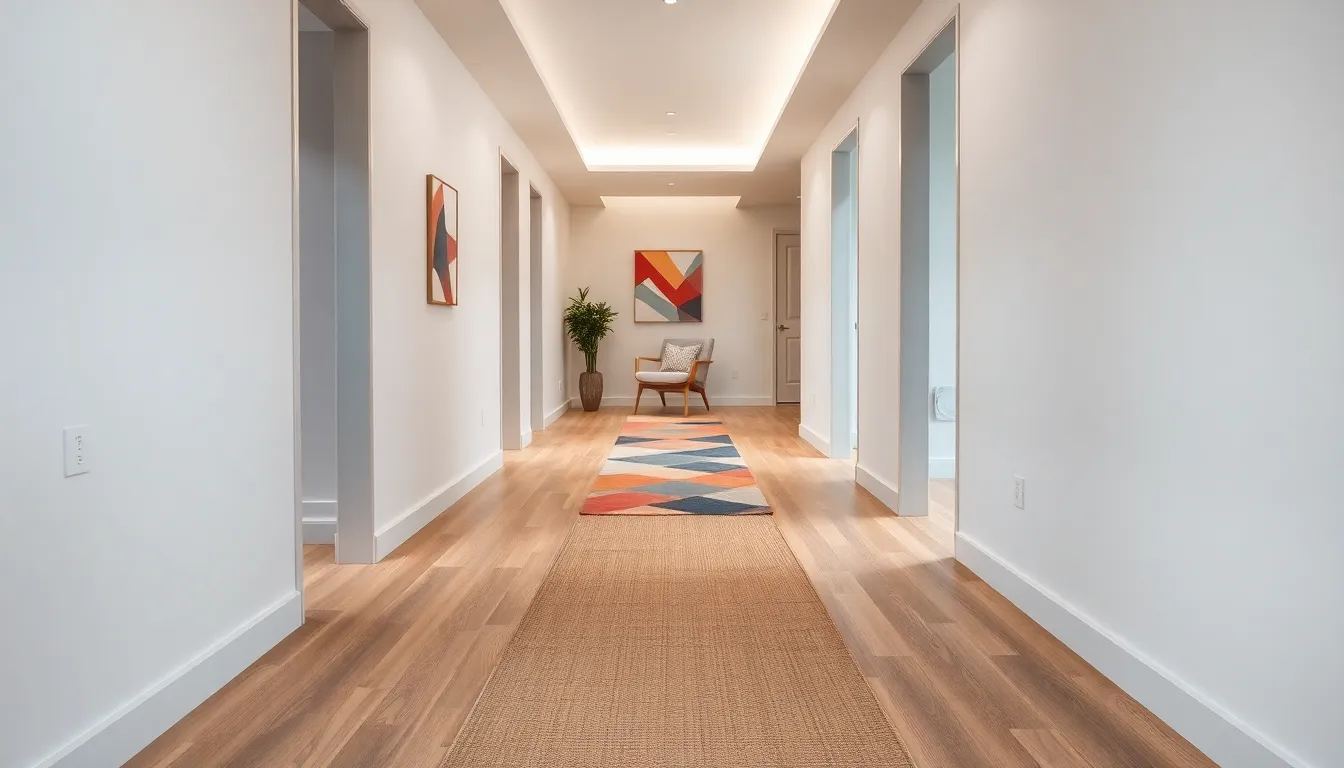
Strategic rug placement transforms your long hallway from a simple passage into a series of defined zones. Rather than treating the space as one continuous corridor, we can create visual segments that add warmth and purpose to each area.
Choose Long Runners for Continuity
Long runners create a cohesive pathway that guides the eye smoothly down your hallway while maintaining visual flow. We recommend selecting runners that span approximately 80% of your hallway’s length to establish continuity without overwhelming the space. This approach acts as a unifying element that ties the entire corridor together.
Scale matters when selecting your runner size because proportion directly impacts how polished your hallway appears. Runners that are too short create a disjointed appearance, while properly sized options complement your hall’s dimensions and enhance its natural flow. We suggest measuring your hallway first and choosing runners that leave 6-12 inches of floor space on each end.
Layer Multiple Rugs for Visual Interest
Layering different rugs adds depth and ever-changing visual appeal to your hallway design without creating overwhelming chaos. We can combine a main runner with smaller accent rugs in seating areas or near doorways to create distinct zones within the longer space. This technique works particularly well when you want to highlight exact areas like reading nooks or display spaces.
Mixing textures and colors through layered rugs creates focal points that draw attention and make your hallway feel intentionally styled. Natural jute runners paired with colorful geometric accent rugs offer an excellent example of successful layering. We recommend limiting your palette to 2-3 complementary colors to maintain visual harmony while adding interest.
Select Patterns That Complement Your Decor
Pattern selection should harmonize with your existing decor style rather than compete with other design elements in your hallway. Subtle geometric patterns work beautifully in minimalist spaces, while bold botanical prints can serve as statement pieces in neutral corridors. We always consider the patterns already present in adjacent rooms to ensure seamless transitions.
Avoid vertical stripes in narrow hallways because they visually emphasize length and can make your space feel even more confined. Instead, we recommend horizontal stripes or organic patterns that help soften the corridor’s proportions and create a wider appearance. Diamond patterns and subtle florals also work exceptionally well in long, narrow spaces.
Add Architectural Elements for Character
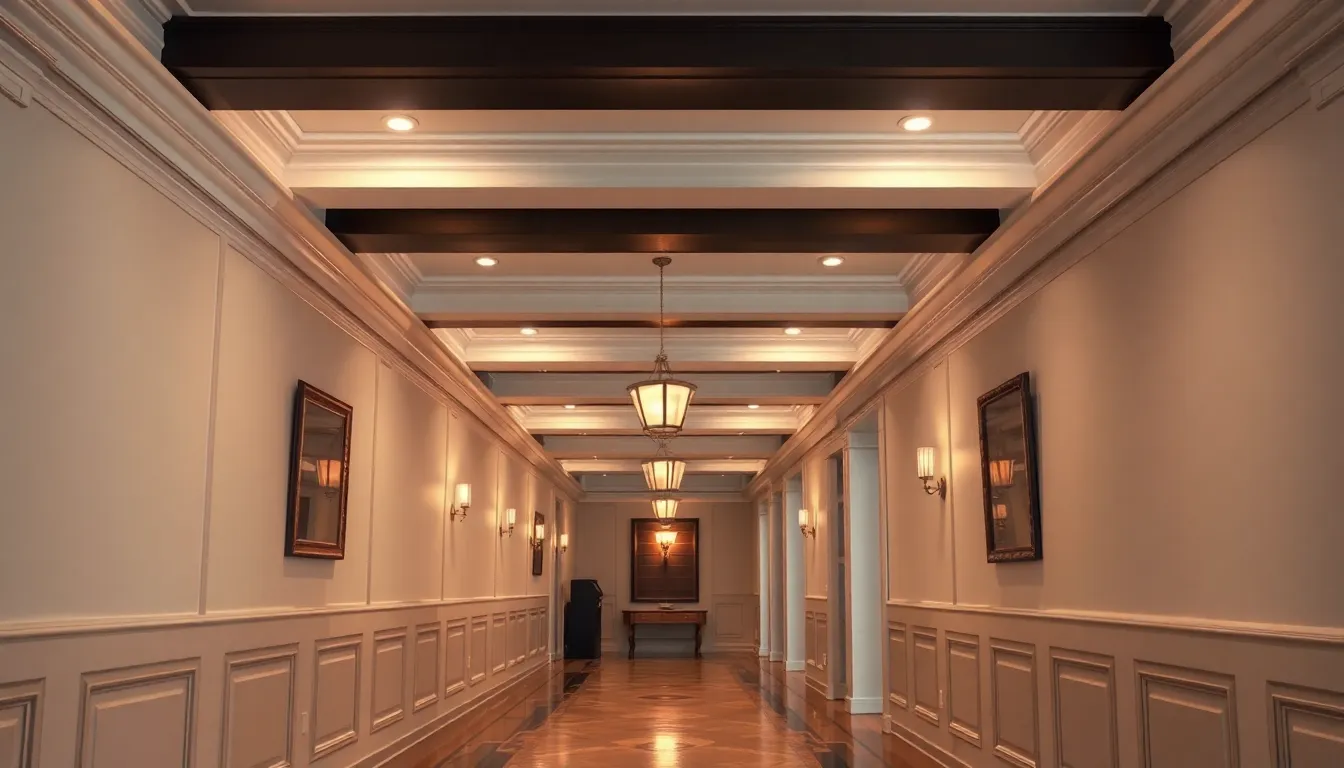
Transforming your long hallway into a stunning architectural feature requires incorporating structural details that create depth and visual interest.
Install Wainscoting or Chair Rails
Installing wainscoting or chair rails instantly adds sophistication to bare hallway walls while creating natural visual breaks that prevent the space from feeling monotonous. We recommend positioning chair rails at 36 inches from the floor to achieve optimal proportions in standard 8-foot ceiling spaces. Wainscoting panels below the chair rail create texture and depth that make narrow corridors feel more substantial and finished.
Choose from traditional raised panel wainscoting for classic elegance or opt for simpler beadboard styles that complement farmhouse or coastal design themes. Paint the lower wainscoting section in darker tones while keeping upper walls light to create visual weight at the bottom and openness above. This technique draws attention to the architectural detail while making the hallway feel wider and more purposeful.
Create Faux Ceiling Beams
Creating faux ceiling beams transforms plain hallway ceilings into dramatic focal points that add architectural character without major structural work. We suggest spacing beams 4 to 6 feet apart along the length of your hallway to create rhythm and visual interest overhead. Lightweight polyurethane beams offer authentic wood appearance while remaining easy to install and maintain.
Position beams perpendicular to the hallway length to create the illusion of width in narrow spaces. Stain faux beams in rich wood tones like walnut or mahogany for traditional appeal, or paint them in contrasting colors for modern design impact. Consider adding recessed lighting between beams to combine architectural interest with functional illumination that enhances the overall hallway ambiance.
Add Crown Molding for Elegance
Adding crown molding creates seamless transitions between walls and ceilings while introducing refined architectural detail that elevates the entire hallway design. We recommend selecting crown molding profiles that measure 3 to 5 inches in height for standard ceiling heights to achieve proper scale and visual impact. Larger profiles work best in hallways with 9-foot or higher ceilings to maintain balanced proportions.
Install crown molding in crisp white or soft cream tones to create clean lines that complement any color scheme you choose for the walls below. Consider adding LED strip lighting behind the crown molding to create indirect ambient lighting that washes the ceiling with soft illumination. This combination of architectural detail and hidden lighting transforms ordinary hallways into sophisticated transitional spaces that rival any main living area in your home.
Bring Life With Plants and Greenery
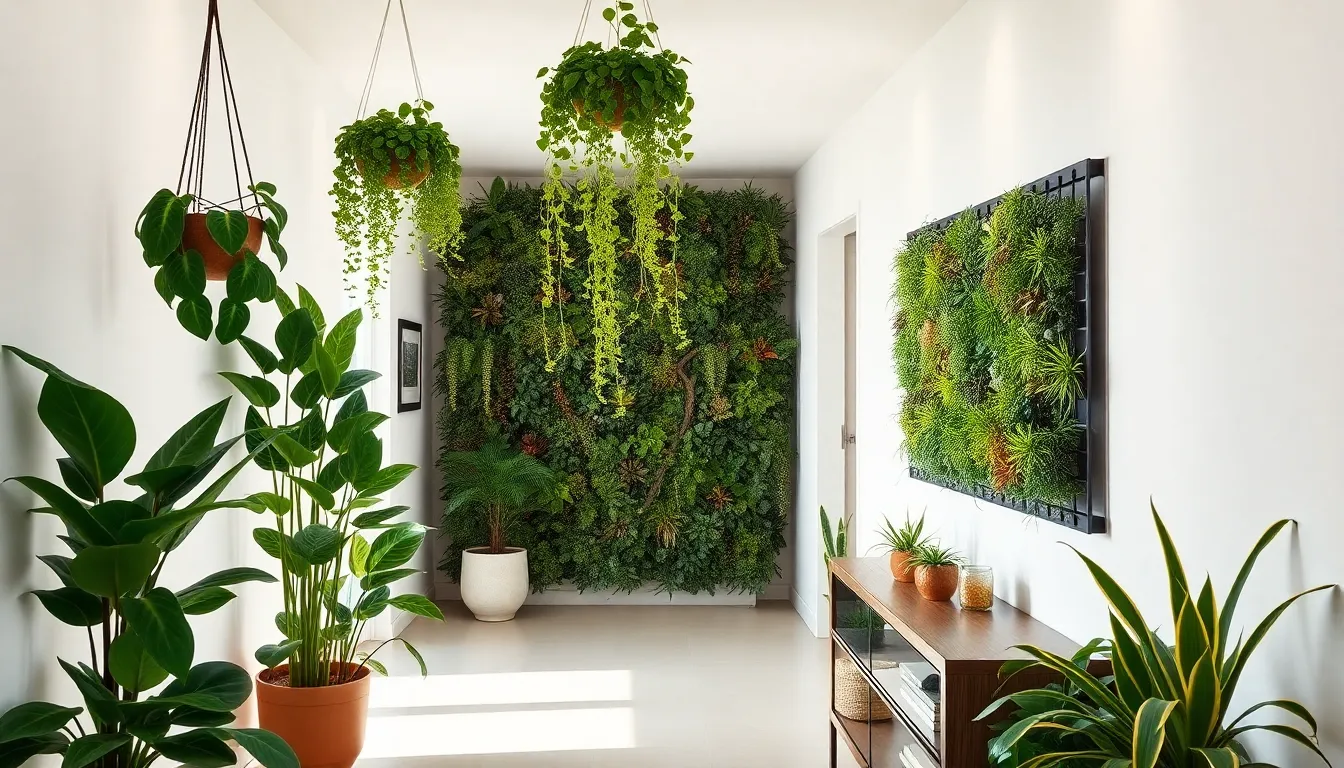
Adding plants and greenery to your hallway transforms a simple corridor into a vibrant living space. Plants naturally soften architectural lines while improving air quality and creating a more welcoming atmosphere.
Use Tall Floor Plants in Corners
Position tall floor plants like fiddle leaf figs or snake plants in strategic corners to maximize visual impact without blocking foot traffic. These statement pieces draw the eye upward, counteracting the tunnel effect common in long hallways while filling otherwise empty vertical space.
Select plants that thrive in lower light conditions since most hallways receive limited natural light throughout the day. Snake plants and ZZ plants excel in these environments, requiring minimal maintenance while providing maximum visual appeal.
Group plants of varying heights to create natural layering that adds depth and prevents the space from feeling flat. Combine a tall floor plant with a medium sized planter on a plant stand for ever-changing visual interest.
Hang Trailing Plants From the Ceiling
Install ceiling mounted planters with trailing varieties like pothos or philodendrons to use overhead space effectively. These cascading plants break up the monotony of long walls while adding texture and movement to your corridor.
Mount planters at varying heights to create a floating garden effect that draws attention away from the hallway’s length. Stagger the placement every 6 to 8 feet to maintain visual rhythm without overwhelming the space.
Choose lightweight hanging systems that won’t damage your ceiling while supporting healthy plant growth. Macrame hangers or modern metal brackets complement different design styles while keeping plants secure.
Create a Green Wall Display
Install a vertical garden system using modular planters or living wall panels to maximize your green impact in minimal floor space. These dramatic installations serve as living artwork that transforms blank walls into botanical focal points.
Combine succulents and air plants in geometric arrangements for low maintenance green walls that thrive in hallway conditions. These varieties require less water and light while providing diverse textures and colors.
Design your green wall in sections rather than covering entire wall surfaces to maintain balance with other decorative elements. A 4 by 6 foot installation provides substantial visual impact without overwhelming your hallway’s proportions.
Style With Decorative Accessories
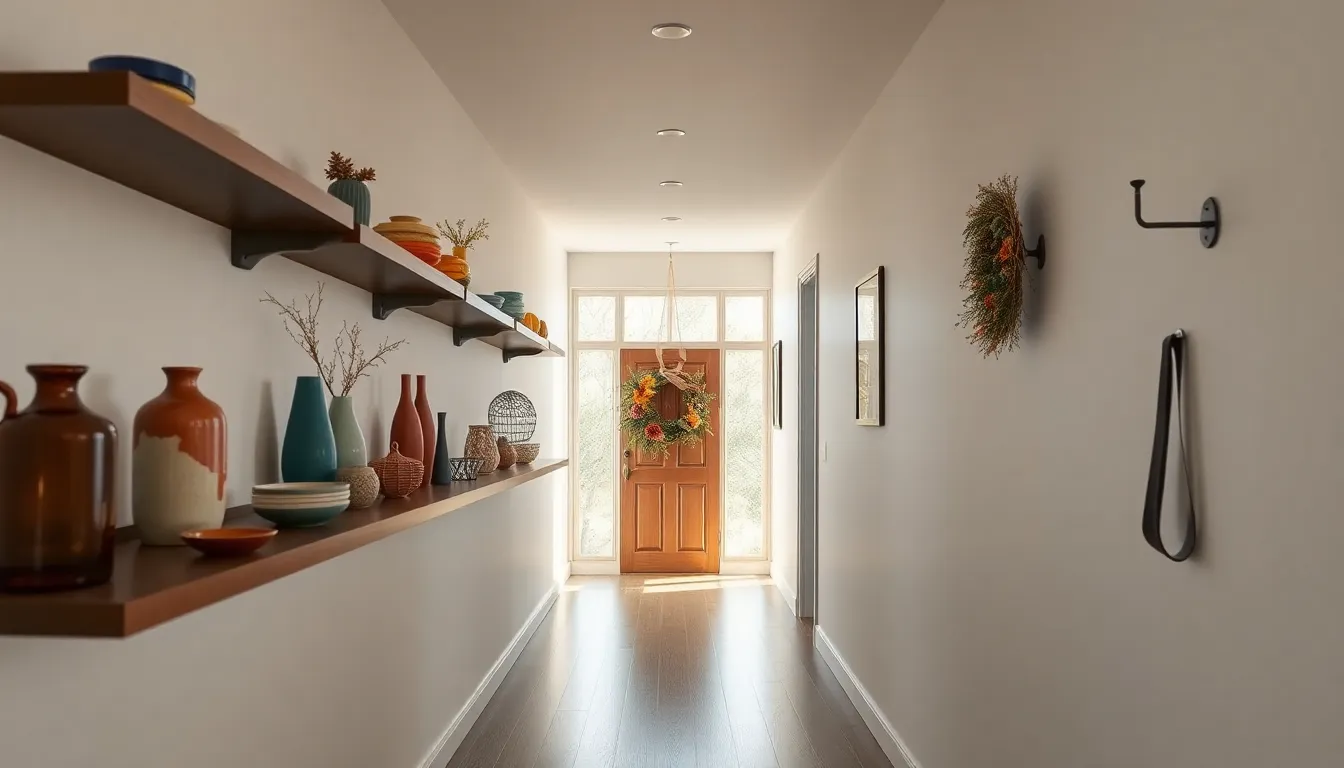
We’ll explore how carefully chosen decorative accessories can transform your long hallway into a stylish, welcoming space that reflects your personal taste.
Display Collections on Floating Shelves
Floating shelves maximize vertical wall space without sacrificing floor area in narrow hallways. We recommend installing them at eye level to showcase your favorite collections like ceramics, books, or decorative objects that add personality to the corridor.
Keeping displays light and minimal maintains an airy feel while breaking up the monotony of long walls. You can arrange items in odd-numbered groupings, alternating heights and textures to create visual rhythm that draws the eye forward through the space.
Collections work best when they follow a cohesive theme or color palette that complements your existing hallway design. Consider rotating seasonal pieces or adding small potted plants between displayed items to keep the arrangement fresh and ever-changing.
Add Sculptural Elements for Visual Appeal
Sculptural elements serve as artful focal points that add depth and sophistication to long corridors. We suggest positioning unique vases, statues, or interestingly shaped lamps on console tables or floating shelves to create visual anchors throughout the space.
Wainscoting or beadboard paneling introduces architectural texture without overwhelming the narrow proportions of your hallway. These elements work particularly well when painted in light, neutral colors that reflect available light and enhance the sense of spaciousness.
Statement pieces should be proportional to your hallway’s scale, with larger sculptures positioned at the end of the corridor to create a dramatic destination point. Smaller sculptural accessories can be distributed along the length to maintain visual interest without creating clutter.
Incorporate Seasonal Decorations
Seasonal decorations offer a ever-changing way to refresh your hallway’s appearance throughout the year. We recommend integrating subtle seasonal touches like themed wreaths, small floral arrangements, or decorative ornaments on existing shelves and console tables.
Changing elements with the seasons keeps your hallway feeling current and prevents the space from becoming stagnant. You can swap out throw pillows on built-in benches, rotate artwork, or update small accessories to reflect spring blooms, autumn colors, or winter textures.
Wall hooks provide perfect mounting points for seasonal wreaths or hanging decorations that don’t require permanent installation. Remember to avoid overcrowding the space with seasonal items, instead choosing a few well-placed pieces that complement your hallway’s established design aesthetic.
Maximize Natural Light Sources
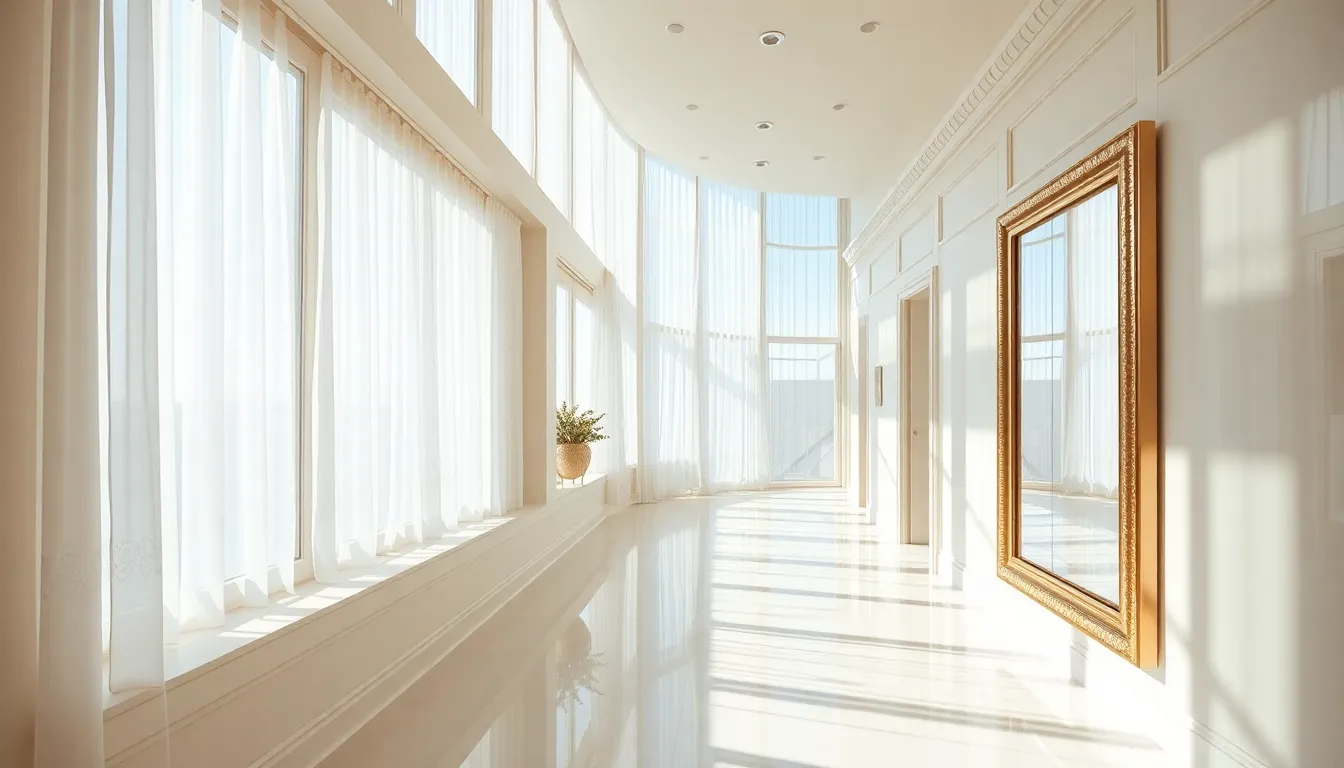
Natural light transforms long hallways from narrow passages into bright, welcoming spaces that feel significantly larger than their actual dimensions.
Keep Windows Unobstructed
Clear pathways for natural light start with removing obstacles that block window openings. We recommend positioning furniture, artwork, and decorative elements away from window areas to allow maximum light penetration throughout the corridor.
Heavy curtains and thick drapes create unnecessary shadows in already narrow spaces. Remove these light-blocking treatments entirely or replace them with minimal alternatives that frame rather than cover the window opening.
Bulky console tables positioned directly beneath windows interrupt light flow and create dark zones. Move these pieces to adjacent walls where they won’t interfere with incoming sunlight while still providing functional storage space.
Use Light-Colored Window Treatments
Sheer curtains in white or cream tones diffuse harsh sunlight while maintaining brightness levels throughout the hallway. These lightweight fabrics filter light gently without creating the dark, tunnel-like effect that heavy treatments produce.
Light-colored blinds in pale wood or white finishes reflect rather than absorb incoming light. Choose horizontal blinds with thin slats that can be angled to direct light toward the ceiling, bouncing illumination deeper into the corridor space.
Minimal hardware in brushed silver or white finishes keeps window treatments virtually invisible. We suggest installing curtain rods that extend slightly beyond the window frame to prevent fabric from blocking any precious natural light when panels are drawn open.
Position Reflective Surfaces Near Windows
Large mirrors placed adjacent to windows effectively double the amount of natural light in narrow hallways. Position these reflective surfaces on walls perpendicular to windows rather than directly opposite to avoid creating glare while maximizing light distribution.
Glossy paint finishes on walls surrounding windows amplify light reflection throughout the corridor. We recommend using semi-gloss or satin finishes in white or pale colors on these strategic wall sections to create a subtle light-bouncing effect.
Metallic accents such as silver picture frames, chrome light fixtures, or brass decorative objects catch and redirect sunlight when positioned near window areas. These reflective elements create sparkle points that draw light deeper into the hallway while adding visual interest to the space.
Conclusion
Transforming your long hallway from a forgotten passageway into a stunning design feature is entirely achievable with the right approach. We’ve covered everything from gallery walls and strategic lighting to architectural elements and natural greenery – each technique working together to create corridors that rival your main living spaces.
The key lies in viewing your hallway as valuable real estate rather than wasted space. Whether you choose bold wallpaper patterns functional storage answers or dramatic mirror displays every element should serve both form and function.
Remember that successful hallway design is about balance. Layer your lighting mix textures thoughtfully and don’t be afraid to make bold choices that reflect your personal style. With these proven strategies you’ll create inviting transitional spaces that guests will remember long after they’ve left your home.
Frequently Asked Questions
How can I make my long hallway look more spacious?
Use mirrors strategically to create the illusion of depth and reflect light throughout the space. Place large statement mirrors at the end of hallways or create mirror gallery walls. Keep windows unobstructed and use light-colored paint or wallpaper. Add proper lighting with wall sconces and table lamps to eliminate dark corners and shadows.
What are the best storage solutions for narrow hallways?
Install floating shelves to maximize vertical space for both storage and display. Use console tables with drawers for hidden storage while maintaining a clean look. Consider built-in storage benches that provide seating and compartments for shoes, coats, and everyday items. These solutions help organize clutter while maintaining visual appeal.
How do I create a gallery wall in my hallway?
Choose a cohesive theme or color palette using 2-3 dominant colors with neutral frames. Mix different frame sizes and shapes for visual rhythm. Plan your arrangement on the floor first to avoid unnecessary wall holes. Follow the 60-30-10 rule: combine 60% purchased art, 30% personal photos, and 10% unique pieces for balance.
What lighting works best for long hallways?
Layer different types of lighting for the best effect. Install wall sconces for ambient lighting without taking floor space. Add table lamps on console surfaces for cozy task lighting. Combine ambient, task, and accent lighting to eliminate harsh shadows and create visual depth throughout the corridor.
How can paint transform my hallway’s appearance?
Use bold accent colors like deep blues or forest greens on one wall while keeping adjacent walls neutral. Try two-tone paint techniques to divide wall space and create architectural interest. Pair paint treatments with wainscoting or chair rail molding for added sophistication and visual breaks in long corridors.
What plants work well in hallways with limited light?
Choose low-light varieties like snake plants, pothos, or ZZ plants for easy maintenance. Place tall floor plants in corners for maximum visual impact. Group plants of varying heights for depth, and consider hanging trailing plants from the ceiling to break up monotony and add vertical interest.
How do I choose the right rug for my hallway?
Select long runners to maintain visual flow throughout the corridor. Use horizontal stripes or organic patterns to soften harsh proportions. Consider layering multiple rugs to create distinct zones and add depth. Ensure the rug width allows comfortable walking space while still defining the area effectively.
What architectural elements can enhance my hallway?
Install wainscoting or chair rails at optimal heights (32-36 inches) for visual breaks and sophistication. Add faux ceiling beams for dramatic focal points. Consider crown molding for refined detail and seamless transitions. These elements combined with strategic lighting can elevate hallways into sophisticated transitional spaces.

